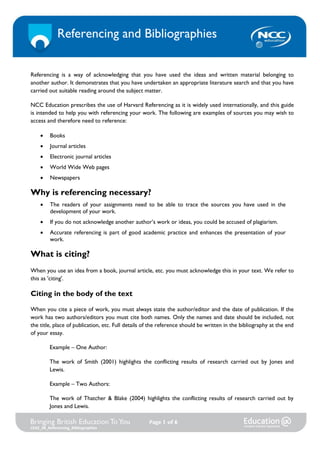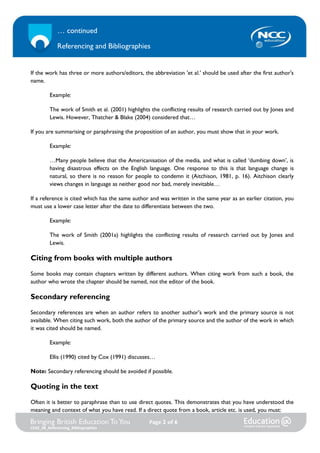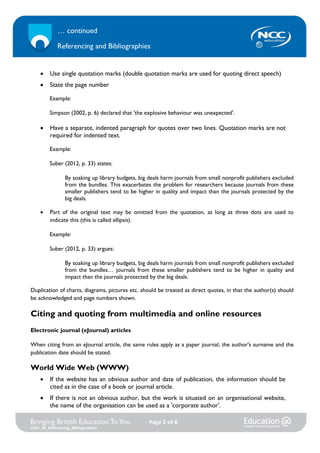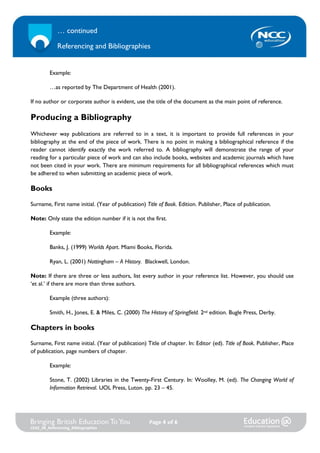NCC EDUCATION Referencing and Bibliographies
- 1. Referencing and Bibliographies Referencing is a way of acknowledging that you have used the ideas and written material belonging to another author. It demonstrates that you have undertaken an appropriate literature search and that you have carried out suitable reading around the subject matter. NCC Education prescribes the use of Harvard Referencing as it is widely used internationally, and this guide is intended to help you with referencing your work. The following are examples of sources you may wish to access and therefore need to reference: ? Books ? Journal articles ? Electronic journal articles ? World Wide Web pages ? Newspapers Why is referencing necessary? ? The readers of your assignments need to be able to trace the sources you have used in the development of your work. ? If you do not acknowledge another author¡¯s work or ideas, you could be accused of plagiarism. ? Accurate referencing is part of good academic practice and enhances the presentation of your work. What is citing? When you use an idea from a book, journal article, etc. you must acknowledge this in your text. We refer to this as 'citing'. Citing in the body of the text When you cite a piece of work, you must always state the author/editor and the date of publication. If the work has two authors/editors you must cite both names. Only the names and date should be included, not the title, place of publication, etc. Full details of the reference should be written in the bibliography at the end of your essay. Example ¨C One Author: The work of Smith (2001) highlights the conflicting results of research carried out by Jones and Lewis. Example ¨C Two Authors: The work of Thatcher & Blake (2004) highlights the conflicting results of research carried out by Jones and Lewis. Page 1 of 6 CEAZ_08_Referencing_Bibliographies
- 2. ¡ continued Referencing and Bibliographies If the work has three or more authors/editors, the abbreviation 'et al.' should be used after the first author's name. Example: The work of Smith et al. (2001) highlights the conflicting results of research carried out by Jones and Lewis. However, Thatcher & Blake (2004) considered that¡ If you are summarising or paraphrasing the proposition of an author, you must show that in your work. Example: ¡Many people believe that the Americanisation of the media, and what is called ¡®dumbing down¡¯, is having disastrous effects on the English language. One response to this is that language change is natural, so there is no reason for people to condemn it (Aitchison, 1981, p. 16). Aitchison clearly views changes in language as neither good nor bad, merely inevitable¡ If a reference is cited which has the same author and was written in the same year as an earlier citation, you must use a lower case letter after the date to differentiate between the two. Example: The work of Smith (2001a) highlights the conflicting results of research carried out by Jones and Lewis. Citing from books with multiple authors Some books may contain chapters written by different authors. When citing work from such a book, the author who wrote the chapter should be named, not the editor of the book. Secondary referencing Secondary references are when an author refers to another author's work and the primary source is not available. When citing such work, both the author of the primary source and the author of the work in which it was cited should be named. Example: Ellis (1990) cited by Cox (1991) discusses¡ Note: Secondary referencing should be avoided if possible. Quoting in the text Often it is better to paraphrase than to use direct quotes. This demonstrates that you have understood the meaning and context of what you have read. If a direct quote from a book, article etc. is used, you must: Page 2 of 6 CEAZ_08_Referencing_Bibliographies
- 3. ¡ continued Referencing and Bibliographies ? Use single quotation marks (double quotation marks are used for quoting direct speech) ? State the page number Example: Simpson (2002, p. 6) declared that 'the explosive behaviour was unexpected'. ? Have a separate, indented paragraph for quotes over two lines. Quotation marks are not required for indented text. Example: Suber (2012, p. 33) states: By soaking up library budgets, big deals harm journals from small nonprofit publishers excluded from the bundles. This exacerbates the problem for researchers because journals from these smaller publishers tend to be higher in quality and impact than the journals protected by the big deals. ? Part of the original text may be omitted from the quotation, as long as three dots are used to indicate this (this is called ellipsis). Example: Suber (2012, p. 33) argues: By soaking up library budgets, big deals harm journals from small nonprofit publishers excluded from the bundles¡ journals from these smaller publishers tend to be higher in quality and impact than the journals protected by the big deals. Duplication of charts, diagrams, pictures etc. should be treated as direct quotes, in that the author(s) should be acknowledged and page numbers shown. Citing and quoting from multimedia and online resources Electronic journal (eJournal) articles When citing from an eJournal article, the same rules apply as a paper journal; the author's surname and the publication date should be stated. World Wide Web (WWW) ? If the website has an obvious author and date of publication, the information should be cited as in the case of a book or journal article. ? If there is not an obvious author, but the work is situated on an organisational website, the name of the organisation can be used as a 'corporate author'. Page 3 of 6 CEAZ_08_Referencing_Bibliographies
- 4. ¡ continued Referencing and Bibliographies Example: ¡as reported by The Department of Health (2001). If no author or corporate author is evident, use the title of the document as the main point of reference. Producing a Bibliography Whichever way publications are referred to in a text, it is important to provide full references in your bibliography at the end of the piece of work. There is no point in making a bibliographical reference if the reader cannot identify exactly the work referred to. A bibliography will demonstrate the range of your reading for a particular piece of work and can also include books, websites and academic journals which have not been cited in your work. There are minimum requirements for all bibliographical references which must be adhered to when submitting an academic piece of work. Books Surname, First name initial. (Year of publication) Title of Book. Edition. Publisher, Place of publication. Note: Only state the edition number if it is not the first. Example: Banks, J. (1999) Worlds Apart. Miami Books, Florida. Ryan, L. (2001) Nottingham ¨C A History. Blackwell, London. Note: If there are three or less authors, list every author in your reference list. However, you should use ¡®et al.¡¯ if there are more than three authors. Example (three authors): Smith, H., Jones, E. & Miles, C. (2000) The History of Springfield. 2nd edition. Bugle Press, Derby. Chapters in books Surname, First name initial. (Year of publication) Title of chapter. In: Editor (ed). Title of Book. Publisher, Place of publication, page numbers of chapter. Example: Stone, T. (2002) Libraries in the Twenty-First Century. In: Woolley, M. (ed). The Changing World of Information Retrieval. UOL Press, Luton. pp. 23 ¨C 45. Page 4 of 6 CEAZ_08_Referencing_Bibliographies
- 5. ¡ continued Referencing and Bibliographies Books which have been translated Surname, First name initial. (Year of publication) Title of book. Translated by First name initial. Surname. Publisher, Place of publication. Example: Kawanishi, M. (2003) The History of Japan. Translated by D. Brown. Hakodate Publishing, Hakodate. Books written in a foreign language Surname, First name initial. (Year of publication) Title of book. [Title in original language.] Publisher, Place of publication. Example: Milani, F. (1994) The Phantom of the Opera. [Le Fant?me De L'Op¨¦ra.] LeRoux, Paris. Journal articles Surname, First name initial. (Year of publication) ¡®Title of article.¡¯ Name of journal, Volume (and number ¨C if relevant), Page numbers of article. Example: Prichard, J. (2006) ¡®Logistics and planning.¡¯ Star Tribune, 36, pp. 44-49. Brown A. and Wesley, C. W. (1995) ¡®An investigation of the Hawthorne effect.¡¯ Management Sciences Journal, 42(1), pp. 47-66. eJournal articles Surname, First name initial. (Year of publication) ¡®Title of article.¡¯ Title of journal, Volume number, Page numbers of the article. Available from: URL [Accessed: Date of access] Example: Fisher, B. (2002) ¡®Time to go Home.¡¯ Journal of Travelling, 6, pp. 122-123. Available from: http://www.alu.ac.uk [Accessed: 6 June 2002] Web Publication There is no agreed standard for referencing Internet sources, but it is important to supply the URL and date the source was accessed, due to the rapidly changing nature of the Internet. Page 5 of 6 CEAZ_08_Referencing_Bibliographies
- 6. ¡ continued Referencing and Bibliographies Author Surname, First name initial. (Year of Publication) Title of webpage. Available from: URL [Accessed on: Date of access] Example: Young, J. (1996) The coherence theory of truth. Available http://www.seop.leeds.ac.uk/entries/truth-coherence/ [Accessed on: 12 January 2013] from: No author Name of source. (Year of Publication) Title of webpage. Available from: URL [Accessed on: Date of access] Example: BBC News. (2007) Graduates ¡®face tough job market¡¯. Available http://news.bbc.co.uk/1/hi/education/6252811.stm [Accessed on: 23 August 2013] from: Newspaper articles Paper copy Reporter Surname, First name initial. (Year of publication) ¡®Title of article.¡¯ Title of newspaper, day and month, page numbers of the article. Example: Kline, J. (2002) ¡®Skills for Leadership.¡¯ Daily Planet, 3 October, p. 27. Note: ? Authors must be presented in alphabetical order in the bibliography, with sources from the same author(s) presented chronologically. Plagiarism is a very serious academic offence. The rule is that you must not represent the ideas of other people as your own. With proper referencing and a full bibliography, this can be avoided. Please also refer to NCC Education¡¯s Guidance on Avoiding Plagiarism and Academic Malpractice. Page 6 of 6 CEAZ_08_Referencing_Bibliographies




![¡ continued
Referencing and Bibliographies
Books which have been translated
Surname, First name initial. (Year of publication) Title of book. Translated by First name initial. Surname.
Publisher, Place of publication.
Example:
Kawanishi, M. (2003) The History of Japan. Translated by D. Brown. Hakodate Publishing, Hakodate.
Books written in a foreign language
Surname, First name initial. (Year of publication) Title of book. [Title in original language.] Publisher, Place of
publication.
Example:
Milani, F. (1994) The Phantom of the Opera. [Le Fant?me De L'Op¨¦ra.] LeRoux, Paris.
Journal articles
Surname, First name initial. (Year of publication) ¡®Title of article.¡¯ Name of journal, Volume (and number ¨C if
relevant), Page numbers of article.
Example:
Prichard, J. (2006) ¡®Logistics and planning.¡¯ Star Tribune, 36, pp. 44-49.
Brown A. and Wesley, C. W. (1995) ¡®An investigation of the Hawthorne effect.¡¯ Management Sciences
Journal, 42(1), pp. 47-66.
eJournal articles
Surname, First name initial. (Year of publication) ¡®Title of article.¡¯ Title of journal, Volume number, Page
numbers of the article. Available from: URL [Accessed: Date of access]
Example:
Fisher, B. (2002) ¡®Time to go Home.¡¯ Journal of Travelling, 6, pp. 122-123. Available
from: http://www.alu.ac.uk [Accessed: 6 June 2002]
Web Publication
There is no agreed standard for referencing Internet sources, but it is important to supply the URL and date
the source was accessed, due to the rapidly changing nature of the Internet.
Page 5 of 6
CEAZ_08_Referencing_Bibliographies](https://image.slidesharecdn.com/ceaz08referencingbibliographies-140223121034-phpapp01/85/NCC-EDUCATION-Referencing-and-Bibliographies-5-320.jpg)
![¡ continued
Referencing and Bibliographies
Author
Surname, First name initial. (Year of Publication) Title of webpage. Available from: URL [Accessed on: Date of
access]
Example:
Young,
J.
(1996)
The
coherence
theory
of
truth.
Available
http://www.seop.leeds.ac.uk/entries/truth-coherence/ [Accessed on: 12 January 2013]
from:
No author
Name of source. (Year of Publication) Title of webpage. Available from: URL [Accessed on: Date of access]
Example:
BBC
News.
(2007)
Graduates
¡®face
tough
job
market¡¯.
Available
http://news.bbc.co.uk/1/hi/education/6252811.stm [Accessed on: 23 August 2013]
from:
Newspaper articles
Paper copy
Reporter Surname, First name initial. (Year of publication) ¡®Title of article.¡¯ Title of newspaper, day and month,
page numbers of the article.
Example:
Kline, J. (2002) ¡®Skills for Leadership.¡¯ Daily Planet, 3 October, p. 27.
Note:
?
Authors must be presented in alphabetical order in the bibliography, with sources from the
same author(s) presented chronologically.
Plagiarism is a very serious academic offence. The rule is that you must not represent the ideas of
other people as your own. With proper referencing and a full bibliography, this can be avoided.
Please also refer to NCC Education¡¯s Guidance on Avoiding Plagiarism and Academic
Malpractice.
Page 6 of 6
CEAZ_08_Referencing_Bibliographies](https://image.slidesharecdn.com/ceaz08referencingbibliographies-140223121034-phpapp01/85/NCC-EDUCATION-Referencing-and-Bibliographies-6-320.jpg)